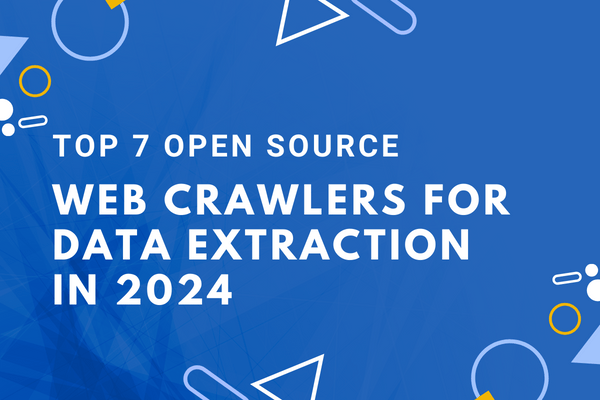What Is A Web Scraper
A web scraper (also known as a web crawler) is a tool or a piece of code that performs the process of extracting data from web pages on the Internet. Various web scrapers have played an important role in the big data boom and make it easy for people to scrape the needed data.
If you’re interested in web scraping, you can read about the 10 myths about web scraping to find more information about its legacy, usage, cases, challenges, etc.
By reading this article, you can learn the top 10 open-source web scrapers and the best easy-to-use web scraper without any coding skills.
Best No-Coding Web Scraper – FREE
Before learning about the top open-source web scrapers, you can learn the best alternative of them which can scrape data without any coding skills. Open-source web scrapers allow users to code based on their source code or framework, but also they have their limits. Especially for non-coding users, it’s hard to do with the customization and takes a lot of time. So, alternatives to open-source web scraper are necessary, especially for non-coding users.
Octoparse, as an easy-to-use web scraping tool, can extract data from any website to Excel with auto-detecting or preset templates. You can finish the whole scraping process within a few clicks, even though you know nothing about coding.
Try the online preset email and social media data scraper below without downloading any software, and just enter the parameters it asked for after you’ve previewed the data sample.
https://www.octoparse.com/template/email-social-media-scraper
However, Octoaprse is also suitable for those who are knowledgeable about coding, it provides advanced functions to customize your data scraping needs. For example, you can use the cloud scraping function to monitor your competitors’ situation scheduling. It also supports IP proxies and rotation to avoid being blocked.
Turn website data into structured Excel, CSV, Google Sheets, and your database directly.
Scrape data easily with auto-detecting functions, no coding skills are required.
Preset scraping templates for hot websites to get data in clicks.
Never get blocked with IP proxies and advanced API.
Cloud service to schedule data scraping at any time you want.
If you’re looking for a data service for your project, Octoparse data service is a good choice. We work closely with you to understand your data requirements and make sure we deliver what you desire.
Top 10 Open-source Web Scrapers
1. Scrapy
Language: Python
Scrapy is the most popular open-source web crawler and collaborative web scraping tool in Python. It helps to extract data efficiently from websites, processes them as you need, and stores them in your preferred format(JSON, XML, and CSV). It’s built on top of a twisted asynchronous networking framework that can accept requests and process them faster. With Scrapy, you’ll be able to handle large web scraping projects in an efficient and flexible way.
Advantages:
- Fast and powerful
- Easy to use with detailed documentation
- Ability to plug new functions without having to touch the core
- A healthy community and abundant resources
- Cloud environment to run the scrapers
2. Heritrix
Language: JAVA
Heritrix is a JAVA-based open-source scraper with high extensibility and is designed for web archiving. It highly respects the robot.txt exclusion directives and Meta robot tags and collects data at a measured, adaptive pace unlikely to disrupt normal website activities. It provides a web-based user interface accessible with a web browser for operator control and monitoring of crawls.
Advantages:
- Replaceable pluggable modules
- Web-based interface
- With respect to the robot.txt and Meta robot tags
- Excellent extensibility
3. Web-Harvest
Language: JAVA
Web-Harvest is an open-source scraper written in Java. It can collect useful data from specified pages. In order to do that, it mainly leverages techniques and technologies such as XSLT, XQuery, and Regular Expressions to operate or filter content from HTML/XML-based websites. It could be easily supplemented by custom Java libraries to augment its extraction capabilities.
Advantages:
- Powerful text and XML manipulation processors for data handling and control flow
- The variable context for storing and using variables
- Real scripting languages supported, which can be easily integrated within scraper configurations
4. MechanicalSoup
Language: Python
MechanicalSoup is a Python library designed to simulate the human’s interaction with websites when using a browser. It was built around Python giants Requests (for HTTP sessions) and BeautifulSoup (for document navigation). It automatically stores and sends cookies, follows redirects, follows links, and submits forms. If you try to simulate human behaviors like waiting for a certain event or clicking certain items rather than just scraping data, MechanicalSoup is really useful.
Advantages:
- Ability to simulate human behavior
- Blazing fast for scraping fairly simple websites
- Support CSS & XPath selectors
5. Apify SDK
Language: JavaScript
Apify SDK is one of the best web scrapers built in JavaScript. The scalable scraping library enables the development of data extraction and web automation jobs with headless Chrome and Puppeteer. With its unique powerful tools like RequestQueue and AutoscaledPool, you can start with several URLs and recursively follow links to other pages and can run the scraping tasks at the maximum capacity of the system respectively.
Advantages:
- Scrape with large and high-performance
- Apify Cloud with a pool of proxies to avoid detection
- Built-in support of Node.js plugins like Cheerio and Puppeteer
6. Apache Nutch
Language: JAVA
Apache Nutch, another open-source scraper coded entirely in Java, has a highly modular architecture, allowing developers to create plug-ins for media-type parsing, data retrieval, querying, and clustering. Being pluggable and modular, Nutch also provides extensible interfaces for custom implementations.
Advantages:
- Highly extensible and scalable
- Obey txt rules
- Vibrant community and active development
- Pluggable parsing, protocols, storage, and indexing
7. Jaunt
Language: JAVA
Jaunt, based on JAVA, is designed for web scraping, web automation, and JSON querying. It offers a fast, ultra-light, and headless browser that provides web-scraping functionality, access to the DOM, and control over each HTTP Request/Response, but does not support JavaScript.
Advantages:
- Process individual HTTP Requests/Responses
- Easy interfacing with REST APIs
- Support for HTTP, HTTPS & basic auth
- RegEx-enabled querying in DOM & JSON
8. Node-crawler
Language: JavaScript
Node-crawler is a powerful, popular, and production web crawler based on Node.js. It is completely written in Node.js and natively supports non-blocking asynchronous I/O, which provides great convenience for the crawler’s pipeline operation mechanism. At the same time, it supports the rapid selection of DOM, (no need to write regular expressions), and improves the efficiency of crawler development.
Advantages:
- Rate control
- Different priorities for URL requests
- Configurable pool size and retries
- Server-side DOM & automatic jQuery insertion with Cheerio (default) or JSDOM
9. PySpider
Language: Python
PySpider is a powerful web crawler system in Python. It has an easy-to-use Web UI and a distributed architecture with components like a scheduler, fetcher, and processor. It supports various databases, such as MongoDB and MySQL, for data storage.
Advantages:
- Powerful WebUI with a script editor, task monitor, project manager, and result viewer
- RabbitMQ, Beanstalk, Redis, and Kombu as the message queue
- Distributed architecture
10. StormCrawler
Language: JAVA
StormCrawler is a full-fledged open-source web crawler. It consists of a collection of reusable resources and components, written mostly in Java. It is used for building low-latency, scalable, and optimized web scraping solutions in Java and also is perfectly suited to serve streams of inputs where the URLs are sent over streams for crawling.
Advantages:
- Highly scalable and can be used for large-scale recursive crawls
- Easy to extend with additional libraries
- Great thread management which reduces the latency of the crawl
Final Thoughts
After learning about the top 10 open-source web scraping tools and their best alternative to get all the data without any coding skills. You can find another top 10 list of free web scrapers that are also easy to use. Choose the one most suitable for you to start your data scraping journey. You can download and install Octoparse to have a free trial if you know nothing about coding, or just want to save your time and energy.




